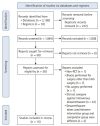Efficacy of perineural versus intravenous dexamethasone in prolonging the duration of analgesia when administered with peripheral nerve blocks: a systematic review and meta-analysis
- PMID: 34963269
- PMCID: PMC9171542
- DOI: 10.4097/kja.21390
Efficacy of perineural versus intravenous dexamethasone in prolonging the duration of analgesia when administered with peripheral nerve blocks: a systematic review and meta-analysis
Abstract
Background: Perineural dexamethasone has been regarded as a promising adjunct for prolonging the duration of nerve blocks. However, it is uncertain whether its effects are due to local effects on the nerves or from systemic absorption. This systematic review aimed to compare the duration of postoperative analgesia associated with perineural versus intravenous dexamethasone as an adjunct to peripheral nerve blocks.
Methods: A total of 2,216 relevant academic articles were identified after a comprehensive search of PubMed, Embase, Scopus, Cochrane Central Register of Controlled Trials, and ClinicalTrials.gov from 1967 until 2020. All randomized controlled trials that compared perineural and intravenous dexamethasone as adjuncts to peripheral nerve limb blocks were included.
Results: Fifteen randomized controlled trials (1,467 cases; 738 perineural dexamethasone, 729 intravenous dexamethasone) were eligible. The primary outcome (duration of analgesia) was significantly longer in the perineural than in the intravenous dexamethasone group (mean difference [MD]: 2.72 h, 95% CI [1.42, 4.01], P < 0.001). Perineural dexamethasone was also found to prolong the sensory block (MD: 3.45 h, 95% CI [1.36, 5.54], P = 0.001) and lower 24 h postoperative pain scores (MD: -0.74 h, 95% CI [-1.40, -0.07], P = 0.03).
Conclusions: This review confirms the greater efficacy of perineural compared to intravenous dexamethasone in prolonging the analgesic duration of peripheral nerve blocks. However, the extent of prolongation was small and may not represent a clinically meaningful difference.
Keywords: Acute pain; Conduction anesthesia; Enhanced recovery after surgery; Nerve block; Pharmaceutic adjuvants; Postoperative pain.
Conflict of interest statement
No potential conflict of interest relevant to this article was reported.
Figures








References
-
- Cardwell TW, Zabala V, Mineo J, Ochner CN. The effects of perioperative peripheral nerve blocks on peri- and postoperative opioid use and pain management. Am Surg 2021: 31348211023395. - PubMed
-
- Joshi GP. Multimodal analgesia techniques and postoperative rehabilitation. Anesthesiol Clin North Am. 2005;23:185–202. - PubMed
-
- Volk T, Engelhardt L, Spies C, Steinfeldt T, Gruenewald D, Kutter B, et al. Incidence of infection from catheter procedures for regional anesthesia: first results from the network of DGAI and BDA. Anaesthesist. 2009;58:1107–12. - PubMed
-
- Huynh TM, Marret E, Bonnet F. Combination of dexamethasone and local anaesthetic solution in peripheral nerve blocks: A meta-analysis of randomised controlled trials. Eur J Anaesthesiol. 2015;32:751–8. - PubMed
Publication types
MeSH terms
Substances
LinkOut - more resources
Full Text Sources

